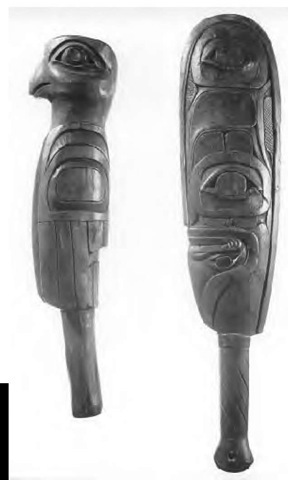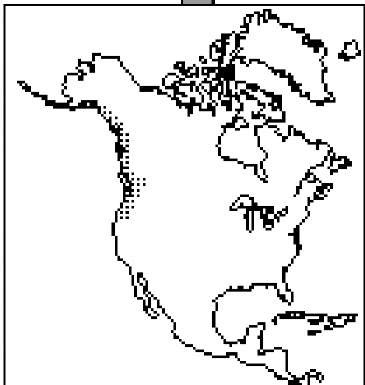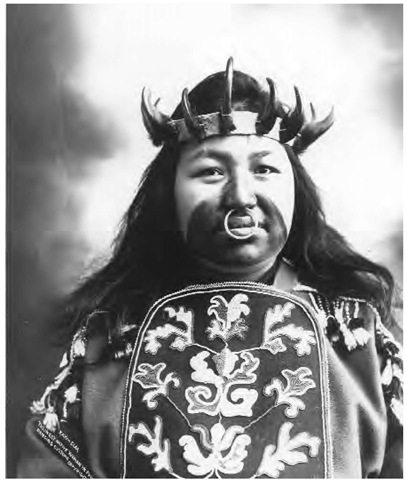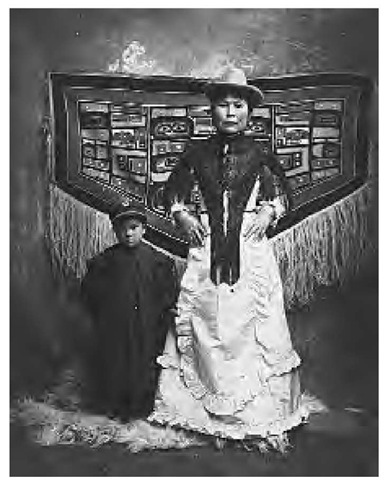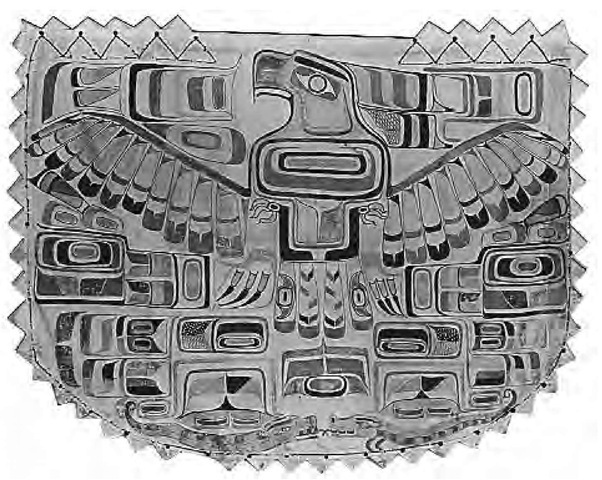For the purposes of this topic, the Northwest Coast geographic region extends from just north of Yakutat Bay in southwest Alaska more or less to the California-Oregon border, including lands west of the Coast and Cascade Mountains. Its length is roughly 1,500 miles, but its width averages less than 100 miles. It is a territory dominated and defined by water.
Especially in the north, great sounds, inlets, and fjords bring the maritime world to people well away from the coast and islands, and numerous rivers further contextualize their liquid world. Depending on elevation and precise distance from the coast, it is an area of seemingly endless fog and rain, fierce winter storms, dense forest, and giant trees. The climate is generally moderate.
The tribes that are spoken of today are modern inventions. Aboriginally, perhaps 165,000 Indians of the Northwest Coast lived in autonomous villages; these and their lineage constituted their political identities. Thus, for example, the people now referred to as the Tlingit tribe were once about 14 separate and distinct Tlingit tribes, such as Chilkat Tlingit, Hoonah Tlingit, and Stikines Tlingit, each of whom shared a dialect, territory, natural resources, and certain inherited rights and obligations. In the north, autonomous local groups occasionally formed military and/or ceremonial alliances. Northwest Coast Indians spoke at least 40 dialects of languages in the Nadene (Athapaskan), Haida, Tsimshian, Wakashan, Chimakuan, Salishan, and Penutian language families.
Almost all Northwest Coast Indian groups shared certain aspects of material culture. Not surprisingly, the sea and/or rivers played a central role in their lives. Fish, especially salmon, was the most important food for most Northwest Coast Indians. Since transportation for most of these groups was by canoe, they were great builders of canoes as well as other finely constructed and carved wooden objects. Trees, especially the red cedar, were the raw materials for everything from canoes to clothing to plank houses. The people generally lived in permanent winter villages but had one or more small permanent, semipermanent, or seasonal villages or camping sites as well.
Aside from life’s necessities, their most important activity was to acquire and maintain wealth and social status. Especially in the north, society was carefully ranked according to hereditary status. The region’s classic ceremonial activity—the potlatch—was both a reflection of and a means to perpetuate this system of social inequality. Religion was based on an individual’s relationship with one or more guardian spirits acquired from the nonhuman world.
With the arrival of non-natives (Spaniards, Russians, British, and, later, Americans) in the late eighteenth and the nineteenth centuries, native Northwest Coast peoples suffered a fate similar to that of other Native Americans. Across the board, populations declined by as much as 90 percent, mostly owing to disease as well as destruction and appropriation of subsistence areas. However, the effects of these changes were uneven; in general, southern and coastal peoples fared worse than northern and more interior peoples.
In the late twentieth century, longhouse kin ties had endured in many places, and tribes in general were moving toward increasing levels of self-government. In the United States, the 1974 Boldt decision (see later discussion of fishing rights in western Washington) secured native fishing rights, although the status of native rights in British Columbia is far less clear. Northwest Indians in general are full participants in contemporary U.S. and Canadian life while at the same time retaining strong native identities.
The first humans entered the Northwest Coast region about 10,000 years ago. Early prehistoric cultures probably came from the interior via the Columbia River and, somewhat later, down the coast and up the river valleys. Technology was characterized by flaked stone industries. Little else is known about the very earliest inhabitants of the region, other than that they adapted quite successfully to the region.
In southwestern Alaska, a new and much better documented stage of cultural development began around 3000 B.C.E. Items of that period, including adzes, labrets, and beads, were fashioned of ground stone and bone. These people ate shellfish and some sea mammals. Later, around 1000 B.C.E., bark mats and poles appear, as do signs of extensive fish and land mammal consumption, more complex tools, and seasonal site occupation. Items consistent with early historic culture date from roughly 1000 C.E.
In northern and central British Columbia as well, changes in the archaeological record, particularly the presence of shellfish middens, indicate that the basic subsistence technology for the following 5,000 years was in place by at least 3000 B.C.E. Sedentary villages appear around 700 B.C.E., and social ranking, woodworking, and distinctive regional art styles shortly thereafter. Intergroup trade was also well established by this time.
Southern British Columbia and northern Washington show a somewhat different pattern. Several distinct cultural periods preceded the final prehistoric pattern, which began in roughly 400 C.E., although in many respects life in the region was little changed from that around 3000 B.C.E. Cultural continuity can be demonstrated along Washington’s ocean coast for at least the past 4,000 years and around Puget Sound for roughly 2,000 years.
Separate and distinct cultures evolved in the Lower Columbia and Willamette Valleys as early as 1560 B.C.E. (Lower Columbia) and 5800 B.C.E. (Willamette Valley). The former featured a fishing economy and larger villages; the latter was based on more diverse subsistence activities and smaller villages or camps. Finally, along the Oregon coast, people moved from a premarine to a marine-based economy early in the first millennium B.C.E., with the marine and riverine culture becoming fully developed by about 500 C.E.
Descriptions of traditional Northwest Coast Indian culture are heavily influenced by what non-Indians observed in the late eighteenth and the nineteenth centuries, by which time many aboriginal elements had been altered. However, what follows is a portrait of aspects probably common to many aboriginal Northwest Coast cultures.
The importance of the potlatch ceremony is denoted by this Tlingit woman’s queenlike costume. The potlatch ceremony was both a reflection of and a means to perpetuate a system of social inequality.
Unidentified woman and child. The photographers’ active studio in Juneau, Alaska, catered to both Indians and non-Indians.
The use of two resources above all defined Northwest Coast Indians: fish, especially salmon, and cedar. Many peoples caught all five kinds of salmon: pink, coho, chum (dog), chinook, and sockeye. Many groups celebrated rituals concerning the season’s first salmon run. Up to 12 methods of salmon fishing were employed, including varieties of nets, spears, and traps. Other important fish included halibut, eulachon (candlefish), smelt, herring, and sturgeon.
Also, many groups availed themselves of abundant quantities of shellfish. Seafood was generally eaten fresh or dried and stored for the winter. Eulachon was used primarily for its oil. Other common foods, in addition to fish and shellfish, included sea mammals, some land mammals, and plants, especially berries (mashed and dried into cakes) and roots such as camas, wapato, and bracken fern. Food was generally eaten fresh, or grilled, boiled (in a basket with hot rocks), or steamed or baked in a pit oven. Mountain goat was hunted for its hair and horn.
The other primary resource, red cedar (redwood in the south), was the backbone of Northwest Coast technology. People used it for clothing, baskets, houses, and canoes as well as for art, ceremonial, and utilitarian objects such as bent-corner boxes, bowls, masks, and heraldic poles. Men worked it with tools such as adzes, chisels, wedges, hammers, drills, and knives. Blades were made of rock, shell, horn, bone, and a small amount of iron. Most carved wood objects were of extremely fine craftsmanship. Although most men could craft objects of wood, canoe making was a distinct profession. Northwest Coast Indians built several types of canoes for specialized activities.
In general, Northwest Coast Indian people fished for eulachon in late winter; gathered seaweed, cedar bark, and herring spawn and fished for halibut in early spring (May); moved to their summer camps around June, where they gathered sea bird eggs and caught salmon; fished and gathered berries, roots, and shoots throughout the summer; preserved the fish and hunted in the fall; and gathered shellfish, hunted sporadically, observed their ceremonies, gambled, told stories, wove, and carved in winter.
Most Northwest Coast societies were ranked according to social status. Status was generally inherited and carried with it certain rights and obligations. Chiefs of local (kin) groups, for instance, tended to be both wealthy and of high birth. They directed large-group activities and wore finer and special clothing. Since it concerned the interests of two kin groups, marriage was a function more of social organization than of life cycle.
Typically, four groups existed: nobility, upper class free, lower class free, and slaves (actually not members of society at all). Each individual was also ranked within the group. Because they were largely based on inheritance, the groups were fairly immutable, although some transfer was possible through acquiring (by trade, purchase, marriage, or war) some inherited rights. These rights, or privileges, owned by the kin group, included songs, dances, performances, and control of subsistence areas and were identified by crests, or design patterns, reflecting real and mythical histories of family lines and associated incidents, animals, and spirits.
All such items were originally obtained by an ancestor from a supernatural spirit. All present members of an opposite division received payment to view a crest, because in so doing they legitimated both the display and the crest’s associated privileges. Resource areas were often "owned" or controlled by kin groups. Among the nobility, status—indeed, the entire system of ranking and kin groups—was confirmed and reaffirmed by a ceremonial obligation called the potlatch.
Potlatching, although it probably increased in intensity during the nineteenth century, was almost certainly part of aboriginal culture. The potlatch was held on varying occasions, such as the succession of a chief, an important life-cycle event, or to save or regain face. Nobles, or chiefs, and their groups invited other chiefs and their relatives from other villages to a feast that lasted for several days. Seating was strictly according to social position. The host and his family would recite their myths and genealogies and give gifts, also according to social position, the acceptance of which also indicated acceptance of the social order.
All potlatches included feasting, socializing, speeches, songs, displays of wealth (such as hammered pieces of copper, pelts, robes, and dentalium shell) and crests, and dances. The original purpose of the institution may have been to exchange goods for food during lean times. Potlatches were held in winter.
This muslin dance robe, fashioned by a Clayoquot artist of the Pacific Northwest in the late nineteenth century, bears a colorful image of the mythical thunderbird. The thunderbird was an important spirit for many Indian peoples.
Around the turn of the century, the "rivalry potlatch," a bitter scene in which the object was to humiliate a rival, was brought about in part because of population decline and consolidation.
Northwest Coast religion centered around the phenomenon of a guardian spirit. Such spirits came from both animate and inanimate objects. They could be individually acquired or inherited; they occasionally arrived uninvited. Individual acquisition of guardian spirits came as the result of spirit quests— bathing, fasting, and praying in remote places—that began when a person was prepubescent and culminated as many as 10 or 20 years later when the spirit power revealed itself. The spirit, associated with a particular song and dance that was displayed during the winter ceremonials, imparted some kind of skill or luck or some special knowledge. Shamans received special spirits that enabled them to cure and/or harm people.
Large rectangular plank houses were the norm along the Northwest Coast. Roof types (shed, gambrel, gable) varied according to location. Several families generally lived in a house, each partitioned off from another, with a particular family’s position in the house determined by rank. Temporary seasonal shelters were built of mats, planks removed from the main house, or bark. House posts were frequently carved and painted with heraldic or crest designs. In fact, most Northwest Coast art was heraldic in nature. In addition to house posts, beams, and fronts, this kind of art was often displayed, especially in the north, in the form of totem (mortuary, memorial, portal) poles.
Weaving was an important nonwood craft. Raw materials included spruce root, cedar inner bark, cattail, tule, mountain goat and dog wool, and bird down. Most women used the twining method to weave baskets (including watertight baskets), clothing (capes, hats, robes), and mats. Coast Salish women spun wool on a full loom. Some clothing was also made of dressed skins, although these were more generally traded for than made locally.
Aboriginally, intragroup conflict was minimal, with the exception of witchcraft, which was a capital offense along with clan incest (among those groups with clans). Intergroup conflict took place within the framework of feuds and wars: The former entailed conflict for a legalistic purpose, whereas the latter existed solely for material gain (land, booty, slaves). In general, the north saw more warfare than the south. Chiefs were the nominal war commanders, and soldiers often undertook practical as well as ritual preparations before fighting. Night raids were the preferred war strategy. Victims’ heads were often displayed on poles as proof of fighting prowess. Defensive tactics included the use of sentries and fortifications.
The first non-natives may have appeared on the Northwest Coast as early as the sixteenth century. However, it was not until Captain James Cook’s crew realized in 1778 the enormous profit in selling Northwest Coast sea otter pelts in China that contact began in earnest. Land-based fur trade operations by Russians, Spaniards, British, and Americans followed shortly after the onset of the maritime fur trade. By about 1850 sea otter stocks had become depleted, and the great non-native fur trade era along the Northwest Coast had come and gone.
During this relatively brief period, diseases such as smallpox and malaria destroyed up to 80 percent or more of some Indian villages. Alcoholism and venereal disease killed more slowly but just as surely. Indians also acquired firearms, iron, sugar, flour, rum, and sails for their canoes during this period. Some strategically placed chiefs became wealthy by monopolizing parts of the fur trade. With the exception of the effects of depopulation, however, and the concentration of remaining populations around trading posts, basic cultural patterns were little disrupted. One significant result of the new wealth accumulated by some groups was the increase in numbers and extravagance of potlatches and the reinvigoration of material culture, including artistic expression.
Though they did not know it, non-native settlers who arrived in the mid-nineteenth century found the Indian population greatly diminished. Perhaps because of the region’s relative inaccessibility, all-out war between Indians and Anglos was largely avoided on the northern Northwest Coast. The United States having only acquired Alaska from the Russians in 1867, its nonmilitary presence was minimal there until the late nineteenth century.
Still, throughout the Northwest Coast, Indians in the late nineteenth century saw further outbreaks of infectious disease as well as intensive missionary work, official efforts to encourage assimilation, severe racial prejudice, and regular anti-Indian violence. Their land was increasingly taken over by non-native squatters while the Indians were legally denied the right to squat on, and thus obtain rights to, their own land. Ultimately, their subsistence patterns and cultural traditions under severe attack, and divided among themselves over the merits of change, most Indians became involved in the wage economy, such as canneries and commercial fishing, built without their permission on their lands.
The United States and Britain fixed their western boundary in 1846 at 49 degrees north latitude. Shortly thereafter, Oregon and Washington Territories were created, and the United States set about extinguishing Indian land title. In Oregon white settlers and miners were allowed simply to dispossess Indians. In the 1850s, treaties were concluded with Washington coastal tribes, providing for land cession and removal to reservations. Reservations in Washington were near or within traditional territory. Most Oregon Indians, however, were removed to two distant reservations following the bitter Rogue River wars of 1851-1855. Conditions there were poor and many starved, and in any case the reservations were soon whittled down by the government. Even in Washington, from 1855 to 1856, a coalition of Puget Sound tribes under the leadership of the Nisqually chief Leschi rose up against their poor treatment at the hands of the whites. Education, including missionization, and agriculture were the primary methods to force the Indians to assimilate. By the early twentieth century, Indian populations were still declining, and many traditions continued to unravel.
Unlike most other North American Indians, the Indians of British Columbia were not conquered militarily, nor did they formally surrender title to their land. In 1884, 13 years after British Columbia joined the Canadian Confederation, the Canadian government simply discounted Indian land ownership and passed its first Indian Act, under which it appropriated land and exercised legal control over Indians within Canada. The first of its two main provisions established roughly 200 small reserves to accommodate the different bands. A reserve could consist of a fishing location, a cemetery, or a village site. The thinking was to permit Indians to remain self-sufficient as they made the transition to a capitalist economy, whereas in the United States policymakers forced various groups of Indians to live together on large reservations, where they were strongly encouraged to become farmers and abandon their traditional identities. The other major provision of the Indian Act outlawed the potlatch; that provision was repealed in 1954.
In 1912, a group of Tlingit and Tsimshian men and women formed the Alaska Native Brotherhood (ANB). This group, with the Native American Sisterhood formed 11 years later, was dedicated to progress as defined by non-native society: Anglo-style education, citizenship, and the abolition of native customs, especially languages and the potlatch (which persisted clandestinely despite its de jure ban). During the 1920s, the ANB broadened its activities to include working against the pervasive institutional and individual discrimination against Native Americans. Today they embrace many of their old traditions, and the ANB remains an active and influential player in Tlingit-Haida-Canadian affairs.
Groups like the Tlingit and Haida Central Council fought for years for aboriginal land claims. The landmark resolution of this fight was the Alaska Native Claims Settlement Act (1971). Under its terms, Alaska’s Tlingit and Haida Indians were organized into regional corporations. In addition, the act created 200 village corporations. Indians born before 1971 were issued shares of their corporation. As of 1996, they are restricted from selling those shares on the open market unless a majority, and in some cases (Tlingit and Haida, for instance) a supermajority of the tribe agrees to do so.
Indians in western Washington have their own landmark legal case. With the rise of the Indian self-determination movement in the 1960s and 1970s, Indians in that region redoubled their efforts to safeguard their fishing rights under the various treaties. For decades, white-owned commercial fishing had been depleting fish stocks so that the Indians, who were guaranteed by treaty the right to fish at their usual places, were decreasingly able to exercise that right. Often Indians were harassed physically and legally for attempting to fish in their usual way. In 1974, Judge George Boldt ruled definitively that the treaty Indians of western Washington were entitled under their treaties to special fishing rights at their "usual and customary" fishing places and to take 50 percent of the allowable salmon harvest in the state. The impact of this ruling has been profound. It includes an explosive growth of Indian fishing and marine-related industries as well as the reinvigoration of local Indian culture.
Since World War II, Canada has tried through federal funds and programs to increase the socioeconomic status of Indians in British Columbia. Since the 1970s, at least, those Indians have fought, with limited success, for an increased share of self-determination. Regional band organizations ("tribal councils") formed in the mid-1970s to press a range of issues, from land claims to services to national political reforms. Despite the reemergence of potlatching and other aspects of traditional culture such as language, rituals, art, performances, and songs after laws against them were removed in 1950s and 1960s, British Columbia Indians still face severe social and economic challenges.
In keeping with the relatively harsh treatment on the Oregon reservations, the federal government in the United States voted to terminate them in 1951— that is, to sell the land and end the government’s relationship with the 61 tribes and bands. Many tribes supported this move. However, when it predictably led to further impoverishment, tribes petitioned for and secured restoration in the 1970s and 1980s. Also in the 1980s, Oregon tribes redoubled their efforts to secure economic development and improved housing and health services.
